Many have taken on the demanding Three Peaks Challenge – walking to the top of Britain’s highest peaks. But when one BRITAIN writer tried it, she discovered an array of beautiful surprises along the way

From the highest mountain in the British Isles – Scotland’s Ben Nevis – to the huge fell of Scafell Pike in England’s Lake District and the mighty Snowdon in Wales, Britain’s three great peaks dominate their surrounding landscapes in some of the most strikingly beautiful locations to be found anywhere in the country. And they’re not just walking and climbing hotspots; they are places of heritage and legend, surrounded by a variety of beautiful and inspiring places to visit.
The imposing Ben Nevis, at the western end of the Grampian Mountains in the Lochaber area of the Scottish Highlands, rises 1,344 metres (4,409ft) above sea level, a powerful mass of snow-capped granite. To the south and west it towers grandly over the town of Fort William, streams and walkways snaking over its hulking sides, but to the north and east it is almost Alpine in scale and character, riven with immense ridges, buttresses and gullies rising from the Allt a’ Mhuilinn (‘mill by the stream’) to the summit plateau.
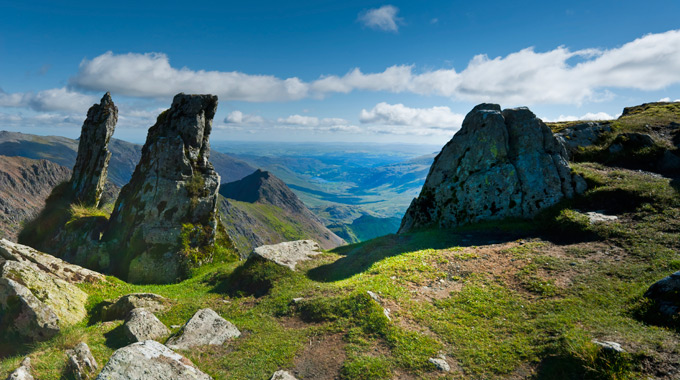
The name Ben Nevis is from the Gaelic, ‘Beinn Nibheis’ – ‘nibheis’ having several meanings but often translated as ‘malicious’ or ‘venomous’. With its hazardous north face and complex climate and topography the mountain is indeed a brooding presence and a formidable opponent for any climber. Another interpretation of the name, however, is that it derives from ‘beinn nèamh-bhathais’, translated literally and affectionately as ‘the mountain with its head in the clouds’.
‘The Ben’, as the locals call it, attracts some 100,000 ascents every year; the majority following the tourist path that winds up the mountain at a relatively easy incline offering panoramic views of distant peaks and the glen below before climbing into the clouds. If you’re after a quiet walk in the peace of the Highlands though, bear in mind that this is a busy route as people take advantage of the well-constructed trail in all but the worst weather. Some will be taking part in the popular Three Peaks Challenge, a mountain endurance test where participants attempt to reach the highest peaks of Scotland, England and Wales in 24 hours, with the aim of fundraising for charity. Ben Nevis is normally the first mountain climbed, and there’s a lighthearted atmosphere along the path as the teams embark on the five-hour walk.
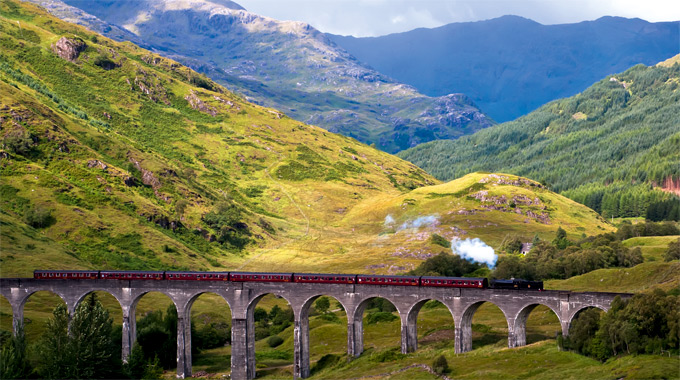
If you prefer to avoid the Three Peak’s teams, climb the mountain from the Nevis Gorge, either by the south-east ridge or via the south-west summit of Càrn Dearg. These routes are shorter but steeper, and tend to be used by experienced hill walkers. For serious climbers and mountaineers the main attraction lies in the steep cliffs of the north face, one of the principal locations in the UK for ice climbing. And for those who don’t mind easy scrambling there’s the spectacular Carn Mór Dearg Arête ridge, which sweeps in a perfect arc towards the north face. The summit features the ruins of an observatory that collected important meteorological data between 1883 and 1904. You can descend from here via the main route and reward yourself with a pint of real ale in the Ben Nevis Inn at the foot of the mountain in Glen Nevis, popular with walkers and locals alike.
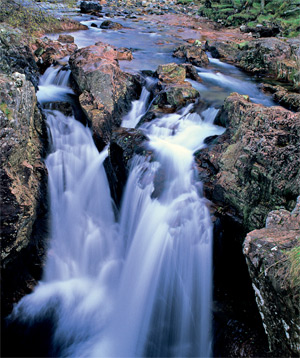
Glen Nevis is bordered to the south by the Mamore mountain range, and to the north by Ben Nevis as well as three of the other 10 highest mountains, or munros, in Britain: the Tolkienesque-sounding Càrn Mor Dearg, Aonach Mòr, and Aonach Beag. The glen is also home to one of the three highest waterfalls in Scotland, Steall Falls, where the Allt Coire a’Mhail (Steall Waterfall River) crashes down over an extraordinary steeply-walled gorge. A beautiful and dramatic setting, it has been used as a location for scenes in Braveheart and the Harry Potter movies. The West Highland Line that connects Fort William at the foot of the glen and Mallaig on the west coast runs over the Glenfinnan Viaduct that was famously crossed by the Hogwarts Express in Harry Potter and the Chamber of Secrets. You can follow the route for yourself aboard the heritage Jacobite steam train that operates along the line in the summer.
Glen Nevis and Fort William have an ancient and turbulent history. Two great battles were fought at the mouth of the glen itself, one in the 15th century and another during the 1745 Jacobite rebellion when government redcoats were besieged at Fort William before raiding the glen. Details of these battles and other romantic tales of the Highland clans can be discovered in the Glen Nevis Visitor Centre. From here you can set off on foot along the forestry paths that offer a choice of wonderful woodland walks.
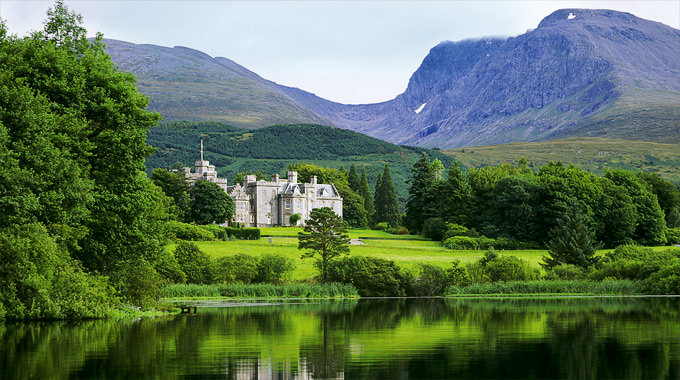
Fort William is also known for its connection to the West Highland Way, Scotland’s oldest long-distance walking route, that runs from Glasgow. A few miles from the end of the route the Inverlochy Castle Hotel, a 19th-century baronial mansion, sits amidst some of Scotland’s finest scenery and is the perfect base from which to relax, explore or enjoy the local hunting and fishing. Queen Victoria spent a week at Inverlochy in September 1873 where she wrote in her diary: “I never saw a lovelier or more romantic spot”.
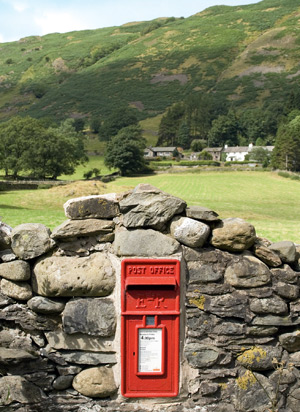
Heading down from the Highlands to the north-west of England and the Lake District National Park, and you’ll find very different but equally impressive scenery, scattered with oak woodlands, fells and a multitude of lakes, meres, tarns and reservoirs. England’s tallest mountain, Scafell Pike, is one of a horseshoe of soaring fells and the highest ground for over 90 miles. On a clear day ramblers are rewarded with incredible views over the surrounding crags and valleys. There are several ascent routes but the summit can only be reached by negotiating some wicked-looking boulder fields. It’s well worth the effort though, not only for the views, but also for the incredible sense of peace and tranquillity that can be experienced in this remote and lofty place.
Scafell Pike and its neighbouring southern fells make this area an important one for walkers. And of course no description of the Lake District would be complete without a mention of one of its greatest advocates – Alfred Wainwright. His seven-volume Pictorial Guide to the Lakeland Fells (1955–1966) has sold over two million copies. Visiting all 214 ‘Wainwrights’ is a feat few achieve, but exploring a selection of these southern peaks, including the Old Man of Coniston, Great End, Esk Pike, Bowfell and the Crinkle Crags to name a few, affords some of the best walks in the country and often without another soul in sight.
You don’t have to be feeling energetic to enjoy the splendour of the Lakes, however. Luxuriate in the spa at The Langdale Hotel near Lake Windermere, or take a stroll in its woodland grounds, interspersed with sparkling streams and tams.
You can channel your inner bard at the Vale of Grasmere, where William Wordsworth made his home, and enjoy spectacular panoramas in every direction while jotting down your poetic musings. A springtime visit to Glencoyne Bay on the western shores of Ullswater is said to have stimulated Wordsworth to write his most famous poem, Daffodils.
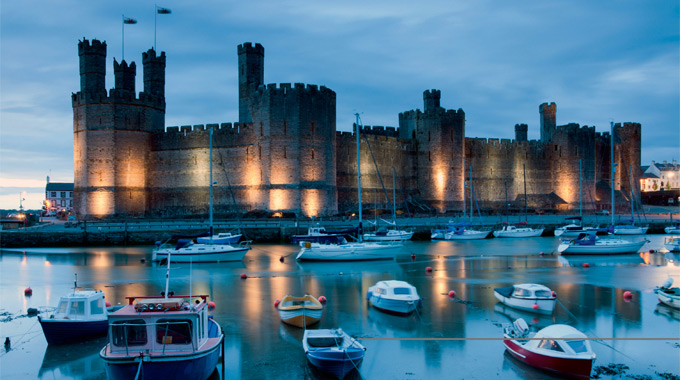
You could follow in his footsteps, try a spot of boating on Grasmere Lake, or take a picnic to beautiful Buttermere or Loweswater, surrounded by dramatic high fells, to enjoy the serene views. Bearing west now, towards the last of Britain’s three peaks, Snowdon has yet another distinct personality. The early English gave it the name Snowdon, but it was called ‘Eryri’ by the Britons because of the eagles that made it their home. Towering 1,085 metres (3,560ft) above sea level in the stunning Snowdonia National Park, it boasts some incredible views towards the Irish Wicklow Mountains. Watching the sun set over Caernarfon Bay from a perch high on the mountain’s slopes is one of the most spectacular sights you will ever see.
The Llanberis Path is the smoothest approach up Snowdon and the most popular, with a wide trail that winds up beside the Snowdon Mountain Railway. It’s pretty steep in places, so many choose to enjoy the views by taking the train that goes all the way to the top and stops at the new Summit Visitor Centre. Mountaineering afi cionados might wish to stay at the Pen-Y-Gwryd Hotel at the foot of the mountain, from where Sir Hillary and Tenzing trained for the fi rst successful ascent of Mount Everest in 1953.
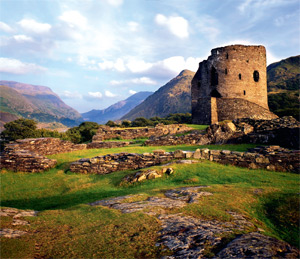
You can continue the railway theme by boarding the steam train on the Llanberis Lake Railway. It runs past the high circular tower of 13th-century Dolbadarn Castle, heads through the 800-acre Padarn Country Park and joins the old slate railway route to run along the shores of the glacially-formed Lake Padarn to Penllyn, offering glorious views of the mountain. The Country Park includes the ancient Coed Dinorwig oak woodland and the Vivian Quarry with its deep blue lagoon. It was part of the huge Dinorwig Quarry complex, which is said to have ‘roofed the world’ and was a hive of industrial activity before it closed in 1969.
A visit to the nearby candy-coloured village of Portmeirion is worthwhile. The delicate architecture is at odds with the rugged surroundings of Snowdonia, but it provides a pretty alternative to the grand views. For the Victorians, the resorts of Aberdovey and Barmouth were ‘the most beautiful watering places in Great Britain’ and Barmouth’s location, between a mountain range and the sea, is particularly picturesque. Located in the south-west corner of the National Park, it is rich with connections to the old shipping and slate industries. There’s a pretty harbour too, bordered by the beautiful Mawddach estuary. It is the perfect place for a vintage seaside holiday, complete with a fairground and donkeys in the summertime.
The call of the mountain draws people back to Snowdon year after year. It is a monument to the rugged and wild splendour of nature and, with its powerful claim on the legend of King Arthur whose knights are said to be sleeping in a cave on the mountain, it’s a place of romance that is imbued with tales of old. Along with Ben Nevis and Scafell Pike, Britain’s three great peaks dominate the countryside for miles around and, as Wordsworth said, their lofty crests “connect the landscape with the quiet of the sky”.
Click here to subscribe!

Related articles
Countryside drives in Scotland





 © 2024
© 2024